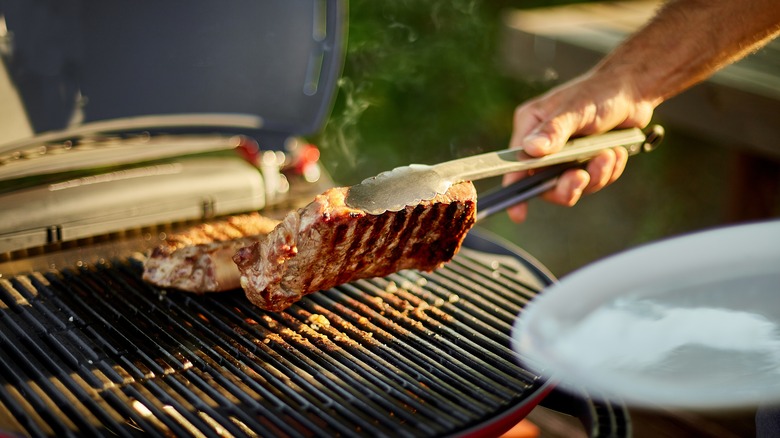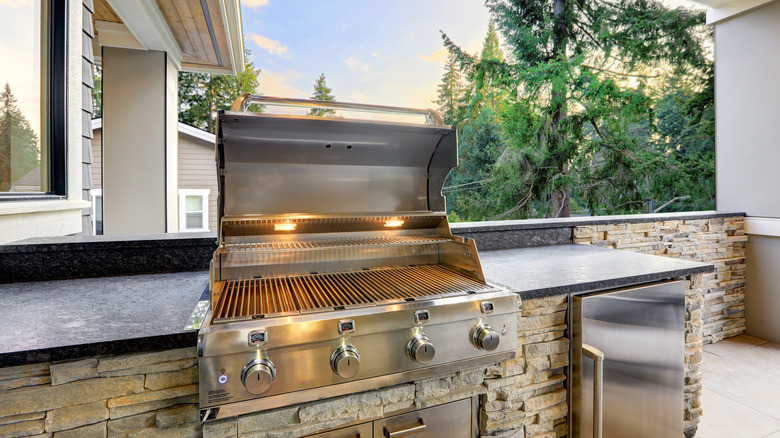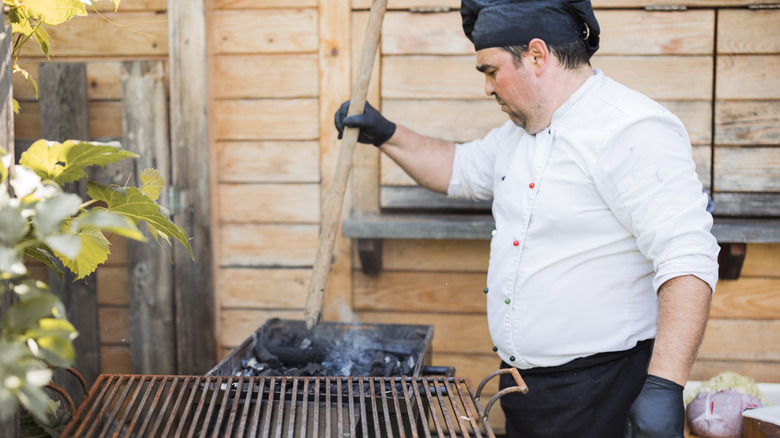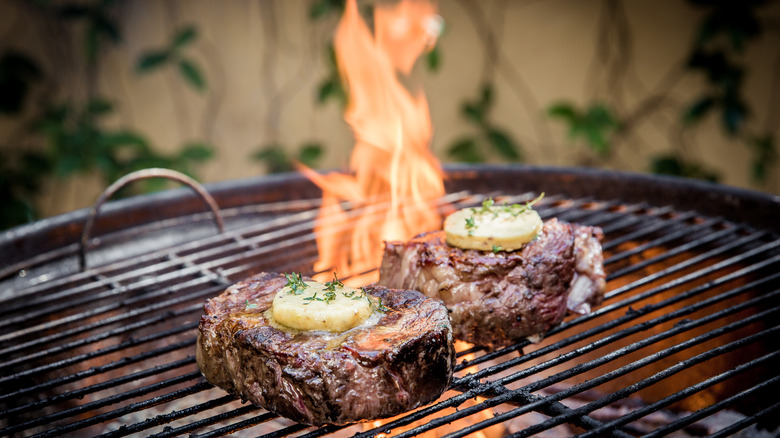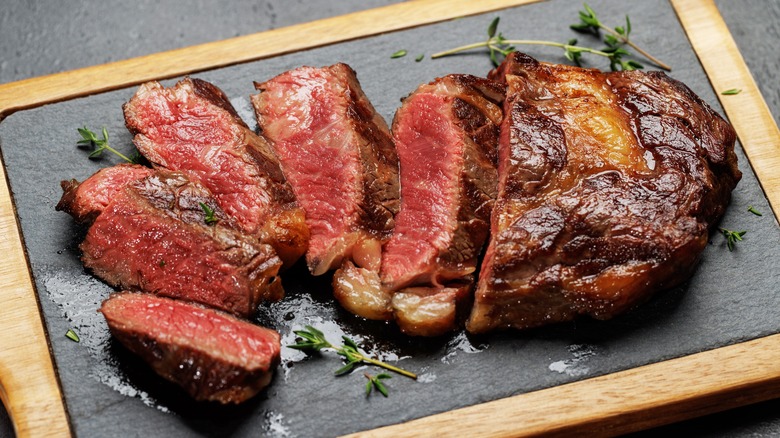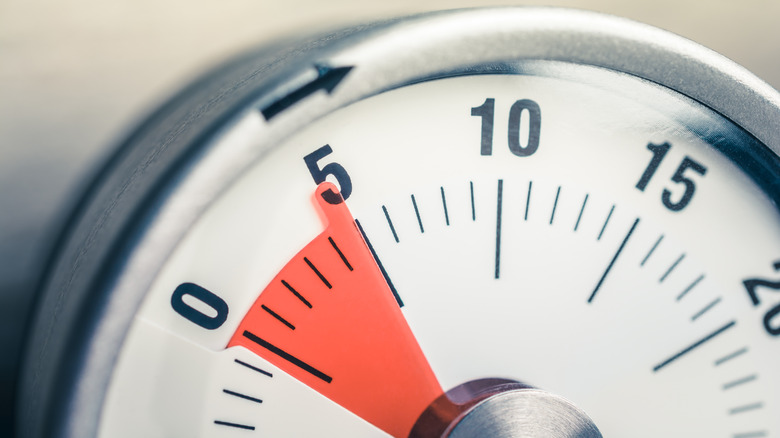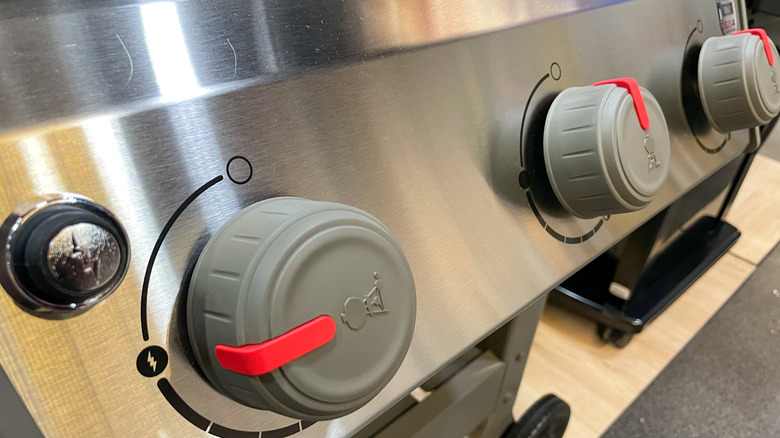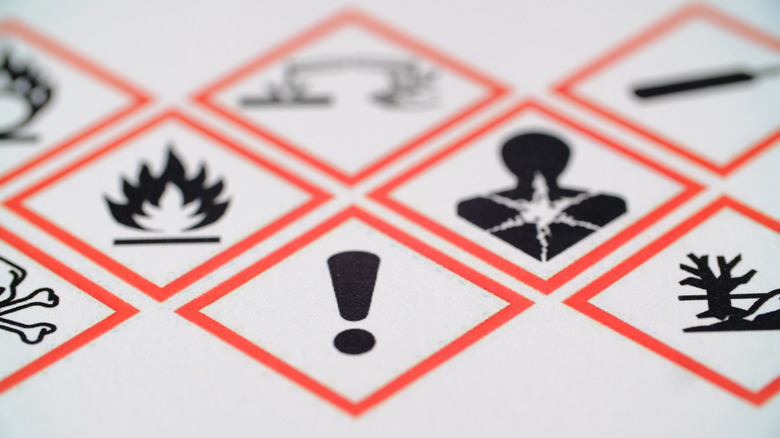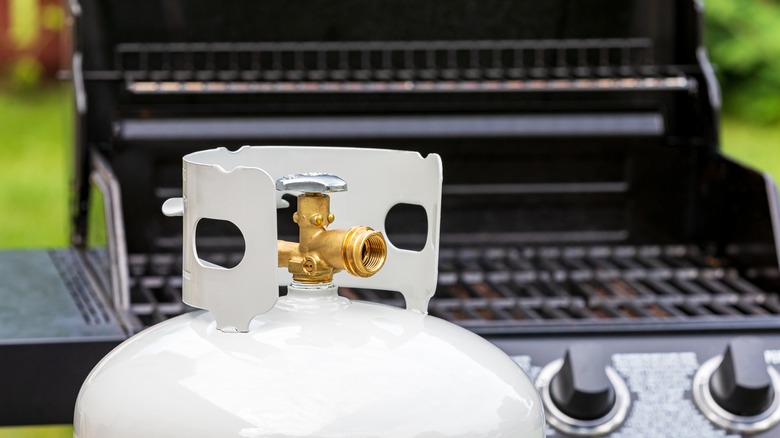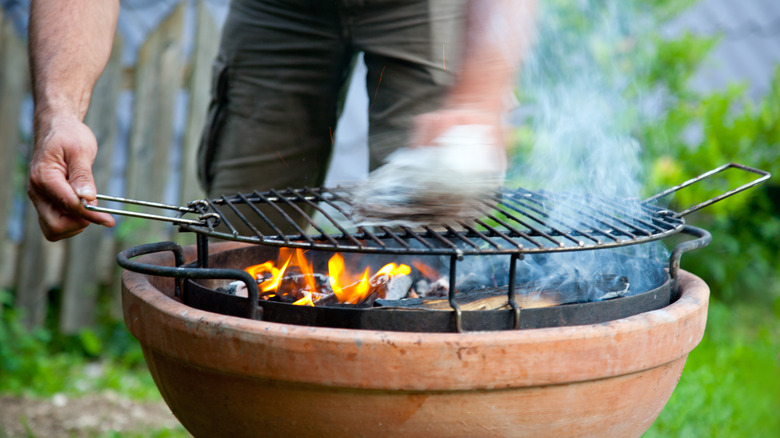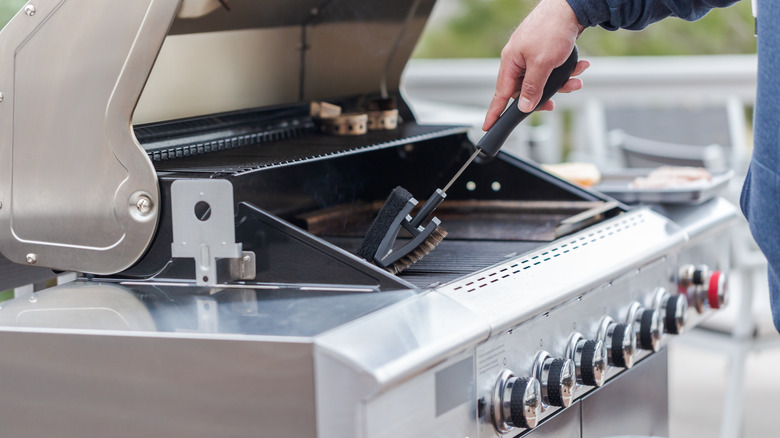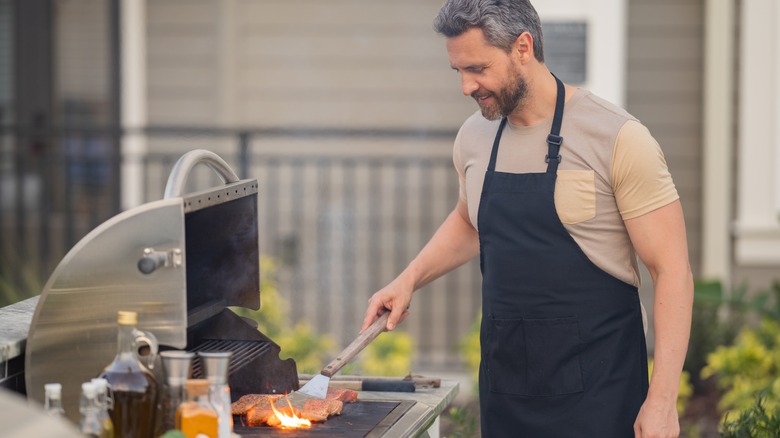Gas Vs Charcoal: Grill Master Reveals That Absolute Best Way To Cook Steak
There's nothing better than a perfectly cooked steak. Whether you lean towards sirloin or ribeye, filet mignon, or New York strip — how the steak is cooked matters. There are many methods for cooking a great steak. Some people throw it right in the oven, others choose to broil it, and the bravest cooks even deep fry it. In the summertime, though, nothing beats steaks cooked on the grill.
There are two types of grills that are commonly used in homes and restaurants: gas grills and charcoal grills. What you might not know is that the experience of grilling a steak on a gas grill is completely different from grilling it on a charcoal grill. Taste, time, convenience, and health benefits should be taken into account when choosing how to cook a steak.
Is one type of grill really better than the other? After talking to the head grill master at Weber, Dustin Green, and catching up on grill and restaurant blogs, we've gathered the most important information that you need to know when choosing how to cook a steak.
How do you cook steak with a gas grill?
If you've been to a family cookout or neighborhood barbecue recently, chances are that you chowed down on food that was cooked on a gas grill. Although they're not the only type of grill, they are currently the most commonly owned type of grill in America.
Cooking a steak on a gas grill is fairly straightforward, but there is still a technique involved. It is important to season the steak before cooking. This can be done while allowing the grill to preheat, which should take between five and 10 minutes.
Once it's time to get cooking, you can place your steaks on direct heat for about three minutes on each side. Then, to get your steaks to have the perfect balance of juice and flavor, place them on indirect heat for around four minutes to finish cooking (the exact time will depend on your preferred steak doneness). Lastly, it's important to let the steak rest. Once it's taken off the grill, let it sit for about seven minutes. This gives the steak's juices a chance to reabsorb into the meat before you cut into it.
How do you cook steak with charcoal?
Cooking with a charcoal grill is a bit more complicated. Some sources say it takes about 15 minutes to heat up the grill, but others claim it can take up to 30 minutes for a charcoal grill to be fully heated — so make sure you factor that into your cooking time. You're working with a live fire, so it's hard to be definitive about timing. It's important to season the steak to your liking before you grill. The charcoal grill adds a smoky flavor to the meat all on its own; however, seasoning is still recommended for the best flavor!
Once the grill is hot, you can place the steaks directly above the coals for approximately two to three minutes on each side, closing the lid. Once that is finished, move the steak to the cooler part of the grill, allowing it to cook on indirect heat for an average of seven minutes. The time you cook on indirect heat depends on the internal meat temperature that you're aiming for.
Just like cooking with a gas grill, you'll want to avoid one of the most common mistakes made when grilling steaks — not letting it rest. No matter the type of stove or grill you cook on, this is a step that cannot be missed. Cutting into the steak too early can cause the juices that help make the steak flavorful to run out.
Charcoal gives steak a distinct smoky flavor
The biggest characteristic of a charcoal grill is that it gives the steak a nice smoky flavor. People say that the unique taste is reminiscent of a crispy piece of bacon. This happens because as the steak cooks, the juices and fat drip down onto the charcoal. When the juices hit the hot surface, they turn into smoke which then goes right back up to the steak, giving it a smoky flavor. The compounds lignin and cellulose are also released by charcoal as it burns, which adds to the taste as well.
This flavor is unique to charcoal grills, as other grill types don't produce as much smoke when cooking. Gas doesn't contribute any extra flavor to a steak, so you're relying on the taste of the beef itself. Ultimately, the charcoal grill intensifies the taste of the steak — adding more nuance to the already-tasty piece of meat.
Dustin Green, head grill master at Weber, told us, "For me, nothing beats the taste of a steak cooked over charcoal. The smoky flavor, rich grill marks, and charred goodness are hard to beat."
Gas creates a juicer steak
There's nothing worse than biting into a delicious-smelling steak and realizing that it's dry as a bone. Good steak should be flavorful, juicy, and easy to chew. If it's taking 30 chews to get one piece down, something is wrong with your cooking method.
One great thing about cooking steak on a gas grill is that it always creates a juicy steak when used correctly. Although it doesn't add any flavor like charcoal or wood grills do, it cooks in a way that allows the juices to stay in the steak. If you're grilling ribeye steaks on a gas grill, you may not miss the extra charcoal taste, as they are known to be one of the juiciest and most flavorful cuts of steak naturally, and the gas grill will help preserve all that moisture and flavor.
Gas grills typically cook at a lower temperature than charcoal, which helps prevent moisture loss that can happen at higher temperatures. The hotter the grill cooks, the more the juices may flow out of the meat. Gas grills' heat levels can be adjusted more easily as well, so the rate at which the meat is cooked can be manipulated a bit more precisely. Overall, this leaves you with a nice, juicy steak.
Charcoal grills take longer to cook meat
The process of cooking with a charcoal grill ultimately takes longer than cooking on a gas grill. First, you need to get the charcoal lit. There are many methods to light a charcoal grill, including using starter fluid, a chimney, or even a tin can. Whatever method you use, it will take five minutes or more to get the charcoal lit.
Once it is lit, you must cover the grill and let it heat up for about 15-30 minutes. So, overall, it takes about 20-35 minutes until you can start cooking the meat. The cooking time once the grill is ready is similar to other types of grills. However, flare-ups can happen on a charcoal grill — this is when the fat drips off of the steak, landing on the charcoal, causing the fire to get bigger and reach up to the steak. This can make your steak burn and char on the outside, which you don't want to happen. Because of this, it sometimes takes longer to cook on charcoal because you are managing the flare-ups and moving the steak around as needed. It's certainly less of a "set it and forget it" process than cooking on gas.
Gas grills can cook steak quickly
Getting a gas grill going is quite simple. It's similar to a stove — you turn the knob while pressing the lighter button, and that's it: Your grill is turned on and heating up. From there, it only takes between about 10-20 minutes on average for the grill to heat up.
On average, it should only take about eight to 14 minutes to cook each steak. Gas grills also tend to have more surface area, so you can cook more steaks at once. If you have a large family, or tend to host barbecues in the backyard, a gas grill makes it easier to quickly cook large numbers of steaks.
Dustin Green, Head Grill Master at Weber gave us some insight on this topic. "For those seeking a quicker grilling experience, a gas grill is a top contender. With a heating time of just 15-20 minutes and the ability to reach high heat temperatures, a gas grill is perfect for a flavorful sear. I rely on my Weber gas grill to cook a variety of steaks when I don't have a lot of time."
Charcoal grills are less expensive than gas grills
The price difference between charcoal and gas grills is an important factor to consider when deciding which grill to buy. On average, a quality charcoal grill can be bought between the price points of $100-$250. For a quality gas grill, that's on the low end; while there are certainly cheaper options, you can easily spend $500 and up.
It's not only the initial price you have to worry about, however. Fuel is needed for both types of grills — and those costs can add up over time. You can get two 20-pound bags of charcoal for $20, which should last for up to 10 steak-cooking sessions. Propane is the most common gas used for gas grills. The average price of propane is around $2.50 per gallon. 20 pounds of propane, which is about 4.6 gallons (which should cost around $11.50), can last for about 18-20 hours of grilling.
When comparing the two, you have to pay more for a gas grill upfront. However, you need to pay for fuel more often for a charcoal grill. Overall, the charcoal grill is still considered the most affordable option because of the upfront costs of a gas grill.
Charcoal can make your meat carcinogenic
When deciding how to cook food, health should be a large determining factor. Therefore, it's important to know that charcoal grills do carry some health risks. High-heat cooking can cause polycyclic aromatic hydrocarbons and heterocyclic amines to form in the meat. These compounds are carcinogens (something that causes or increases the risk of cancer). Since charcoal grills get much hotter than other types of grills, that risk factor is present.
Now, it is not guaranteed that every time you cook a steak on a charcoal grill, you are increasing your risk of cancer. There are ways to cook with the grill that help inhibit the compounds from forming. For example, if you use a leaner cut of meat, then you have a lower chance of releasing carcinogens with the high heat of the charcoal grill. Other preventative techniques include marinating the steak and seasoning with herbs and spices. It's not clear why this technique minimizes the formation of carcinogenic compounds; one hypothesis is that herbs and spices have antioxidants that help prevent the formation of carcinogens. Lastly, if you pay close attention to making sure you don't burn or char the steak, that will ensure a healthier meal as well.
Gas grilling can be hazardous if not done properly
No matter the kind of cooking, it is always important to be cautious and safe when using any form of heat, fuel, and kitchen supplies. Grilling with a gas grill has its own risks, mainly because of the fuel source.
Gas tanks must be taken care of properly or they could leak and cause an explosion. Gas lines must be checked often, tanks shouldn't be rusted or damaged, and the space surrounding the grill must be kept clear. The grill must also be kept clean in order to prevent fires from grease. If the grill owner is vigilant, potential fires and accidents can be avoided.
Each year, there are approximately 9,000 grill fires in the United States, according to Travelers Insurance. Approximately 83% of these fires are from gas grills. So, if you want to enjoy a delicious steak on a summer afternoon — remember, safety first. Proper precautions need to be taken when being a grill owner, especially if you are using gas.
Charcoal grills get dirty quicker, but they're easy to clean
If you want a smoky, well-cooked steak and don't mind cleaning your grill, charcoal is probably for you. These grills tend to be less complicated than other grills — they don't have many nooks and crannies or complicated mechanisms to tend to once the cooking is over.
Although the charcoal grill can still get messy with all the residue from the burning charcoal it isn't complicated to give it a good clean after every cooking session. The main thing that needs to be done is to clean the grates. Grab your favorite grill brush and brush those grates down. Once the buildup is scraped away, you can clean with warm soapy water and a sponge.
Most charcoal grills also have a simple cleaning system for the bottom of the grill, in which blades rotate to push the debris and build-up into a container below. From there, you can empty the container out seamlessly. Just like the other areas of the grill, you can finish off with warm soapy water and a sponge in the base of the grill.
The inside of the charcoal grill lid tends to get a build-up of grease. If you scrub that area with a grill brush and finish with warm soap and water, that grease will easily come off. It's also important to clean the outside of the grill, which can be quickly done with your cleaning spray of choice and a sponge.
Gas grills need more overall maintenance
Although the clean-up after a grill session on a gas grill isn't incredibly involved, there is overall maintenance to be aware of. The gas grill has complex mechanisms that need to be cleaned and cared for to ensure safe and clean cooking. About once or twice a grill season, the grill needs a deep cleaning. It may take some time, but the effort allows you to have less clean-up time after every cooking session.
Many gas grills have stainless steel features that need to be cleaned carefully with stainless steel spray. The inside and outside of the lid can be cleaned with warm, soapy water. If there is grease residue, a grill brush can be used to scrape it off before scrubbing clean.
The cooking grates should be scraped with a grill brush and then followed up with soap and water. After that, the burner tubes need to be cleaned individually with a grill brush. Next, the cook box should be scraped clean. Many gas grills have a removable bottom tray that the residue will fall into, so you can remove that and clean it with soap and water.
Catch pans must be cleaned with soap and water, and occasionally changed out with a fresh aluminum pan. Warming racks and grilling baskets can also be cleaned with soap and water. Gas tanks should be checked for any issues, as well as the gas lines and surrounding areas.
The type of grill you use depends on personal preference
We spoke to Dustin Green, head grill master at Weber, and he gave us some insights on how the company assists its clients when they're choosing between types of grills. He said that price point, grilling experience, preference of fuel type, and other factors help him guide clients into making an easy decision on what grill they use.
After our research on the matter, we can see that there truly is no "better" way to cook a steak. Some people want to have that distinct smoky flavor on their steak from a charcoal grill. Others prefer the juicier, cleaner-tasting steak that you can achieve from cooking on a gas grill. Overall cost and maintenance can matter to individuals as well, as some people don't mind spending more money or more time on maintaining their grill.
With all these factors coming into play, it truly is up to what the individual wants out of their steak-cooking experience. So, whether you choose a charcoal-cooked steak or a gas-grilled steak, there are benefits to both that will leave you with a satisfying meal no matter what.
